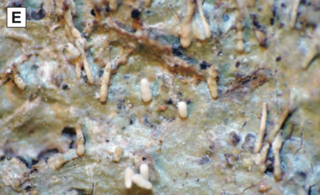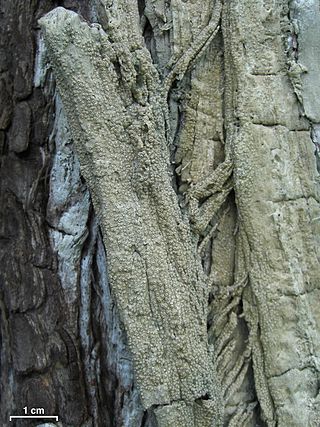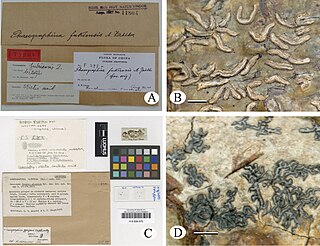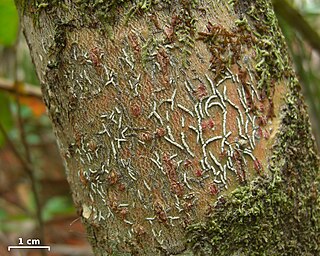
The Graphidaceae are a family of lichen-forming fungi in the order Graphidales. The family contains nearly a hundred genera and more than 2000 species. Although the family has a cosmopolitan distribution, most Graphidaceae species occur in tropical regions, and typically grow on bark.

Fissurina is a genus of lichenized fungi in the family Graphidaceae. It has about 160 species, most of which are found in tropical regions.

Myriotrema is a genus of lichen-forming fungi in the family Graphidaceae.
Melanotrema is a genus of lichen-forming fungi in the family Graphidaceae. The genus was circumscribed by German lichenologist Andreas Frisch in 2006, with M. platystomum assigned as the type species.
Leucodecton is a genus of lichen-forming fungi in the family Graphidaceae. The genus was circumscribed in 1860 by Swiss lichenologist Abramo Bartolommeo Massalongo, with Leucodecton compunctum assigned as the type species.
Chapsa is a genus of lichens in the family Graphidaceae. The genus was circumscribed by Italian lichenologist Abramo Bartolommeo Massalongo in 1860.

Acanthotrema is a genus of lichens in the family Graphidaceae. The genus was circumscribed by German lichenologist Andreas Frisch in 2006, with Acanthotrema brasilianum assigned as the type species. Acanthotrema species are commonly found in rainforests ranging from lowland to montane environments.

Stegobolus is a genus of lichen-forming fungi in the family Graphidaceae.
Echinoplaca is a genus of lichens in the family Gomphillaceae.
Ampliotrema is a genus of lichen-forming fungi in the family Graphidaceae. The genus was originally described invalidly in 2004, and validly two years later.

Malmidea is a genus of crustose lichens and the type genus of the family Malmideaceae. It was established in 2011 to contain a phylogenetically distinct group of species formerly placed in the genus Malcolmiella. The crust-like thallus of Malmidea lichens has a surface that varies from smooth to rough, featuring textures such as verrucose (wart-like), granulose (grainy), or pustulate (pimpled). These textures are often formed by goniocysts, which are spherical clusters of green algal cells from the family Chlorococcaceae, encased in fungal hyphae. Malmidea comprises nearly 70 mostly tropical species that grow on bark, although a few grow on leaves.

Coenogonium is a genus of filamentous lichens in the monotypic family Coenogoniaceae. It has about 90 species. Most species are leaf-dwelling or grow on bark, although a few are known to grow on rocks under certain conditions, and some are restricted to growth on termite nests. The genus was circumscribed in 1820 by German naturalist Christian Gottfried Ehrenberg.
Wirthiotrema is a genus of lichen-forming fungi in the family Graphidaceae. The genus was circumscribed in 2010 by Eimy Rivas Plata, Klaus Kalb, Andreas Frisch, and H. Thorsten Lumbsch, with Wirthiotrema glaucopallens assigned as the type species. Wirthiotrema contains species that were formerly considered part of the Thelotrema glaucopallens species group. The genus name honours lichenologist Volkmar Wirth, "for his numerous outstanding contributions to lichenology".
Rhabdodiscus is a genus of script lichens in the family Graphidaceae. It has 36 species.

Heiomasia is a genus of corticolous (bark-dwelling), crustose lichens in the family Graphidaceae. It has five species.
Cruentotrema is a genus of corticolous (bark-dwelling) lichens in the family Graphidaceae. It has seven species.

Robert Lücking is a German lichenologist. He earned his master's and PhD from the University of Ulm, focusing on the taxonomy, ecology, and biodiversity of foliicolous lichens. He has received numerous awards for his work, including the Mason E. Hale Award for his doctoral thesis, the Augustin Pyramus de Candolle prize for his monograph, and the Tuckerman Award twice for his publications in The Bryologist. Since 2015, he has been serving as the curator of lichens, fungi, and bryophytes at the Berlin Botanical Garden and Botanical Museum, and several lichen species and a genus have been named in his honour.

Graphidales is an order of lichen-forming fungi in the class Lecanoromycetes. It contains 6 families, about 81 genera and about 2,228 species. Family Graphidaceae are the largest crustose family within Graphidales order comprising more than 2000 species, which are widely distributed in tropical and subtropical regions of the world.
Gintarasia is a genus of lichen-forming fungi in the family Graphidaceae. It has seven species, all of which are found in Australia. Gintarasia species are corticolous (bark-dwelling), crustose lichens with a thelotremoid form.

Dyplolabia afzelii is a species of corticolous (bark-dwelling), script lichen in the family Graphidaceae. It has a pantropical distribution. The lichen has a thallus with colours ranging from yellow to pale olive buff, dark brownish tan, or grey, characterised by its smooth texture and considerable thickness. Its ascomata are lirelline, often raised from the thallus surface and concealed under a powdery white layer.











